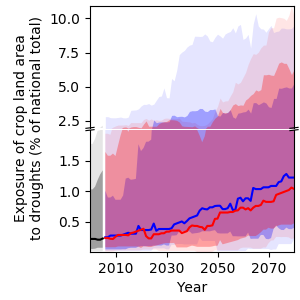Tanzania: Agriculture
Smallholder farmers in Tanzania are increasingly challenged by the uncertainty and variability of weather caused by climate change [19], [20]. Since crops are predominantly rainfed, they depend on water availability from precipitation and are prone to drought. However, the length and intensity of the rainy season is becoming increasingly unpredictable and the use of irrigation remains limited. The national crop land suitable for irrigation is estimated at 29.4 million ha [7]. Currently, only 1.5 % of this potential is irrigated. However, Tanzania has been investing in irrigation and is planning to almost triple its total irrigated area to 1.24 million ha by 2035 [21]. This expansion is motivated by hopes to increase the productivity of rice, which, along with maize, is the main irrigated crop in Tanzania [21].
Crop land exposure to drought

Currently, the high uncertainty of projections regarding water availability (Figure 10) translates into high uncertainty of drought projections (Figure 11). According to the median over all models employed for this analysis, the national crop land area exposed to at least one drought per year will increase by a factor of five in response to global warming. Under RCP6.0, the likely range of drought exposure of the national crop land area per year widens from 0.05–1.0 % in 2000 to 0.5–6.2 % in 2080. The very likely range widens from 0.01–1.8 % in 2000 to 0.2–10.1 % in 2080. This means that most models project a significant increase in drought exposure over this time period.
Crop yield projections

In terms of yield projections, millet, sorghum, rice, groundnuts and cassava are projected to gain from climate change (Figure 12)5. Under RCP6.0, crop yields are projected to increase by 22 % for millet and sorghum, 18 % for rice, 22 % for groundnuts and 31 % for cassava by 2080 relative to the year 2000. These positive results can be ascribed to the CO2 fertilisation effect, which benefits plant growth. Rice, groundnuts and cassava are so-called C3 plants, which follow a different metabolic pathway than maize (C4 plant), and thus benefit more from the CO2 fertilisation effects under higher concentration pathways. Maize yields are projected to slightly decrease under RCP2.6 and remain at current levels under RCP6.0. The decrease under RCP2.6 can be explained by non-temperature related parameters such as changes in precipitation patterns, while the projections for RCP6.0 can be explained by CO2 fertilisation. Regional climate variability will likely cause crop yields to increase in some areas, while simultaneously decreasing in others.
Overall, adaptation strategies such as switching to high-yielding improved varieties in climate change sensitive crops should be considered, yet carefully weighed against adverse outcomes, such as a resulting decline of agro-biodiversity and a loss of local crop types.
5 Modelling data is available for a selected number of crops only. Hence, the crops listed on page 2 may differ. Maize, millet and sorghum are modelled for all countries.
References
[19] P. M. Luhunga, A. L. Kijazi, L. Chang’a, A. Kondowe, H. Ng’ongolo, and H. Mtongori, “Climate Change Projections for Tanzania Based on High-Resolution Regional Climate Models From the Coordinated Regional Climate Downscaling Experiment (CORDEX)-Africa,” Front. Environ. Sci., vol. 6, no. October, pp. 1–20, 2018.
[20] P. Rowhani, D. B. Lobell, M. Linderman, and N. Ramankutty, “Climate Variability and Crop Production in Tanzania,” Agric. For. Meteorol., vol. 151, no. 4, pp. 449–460, 2011.
[21] JICA, “The Project on the Revision of National Irrigation Master Plan in the United Republic of Tanzania,” Tokyo, Japan, 2018.


